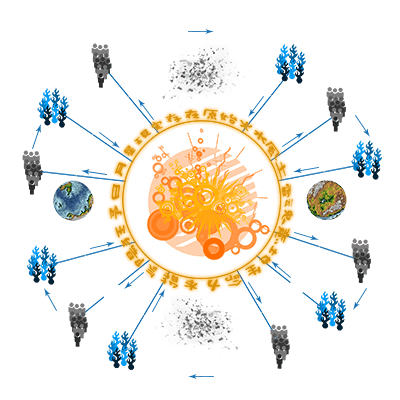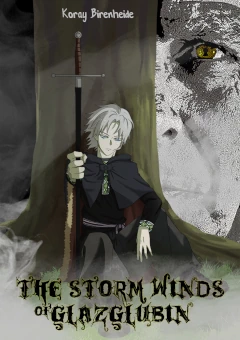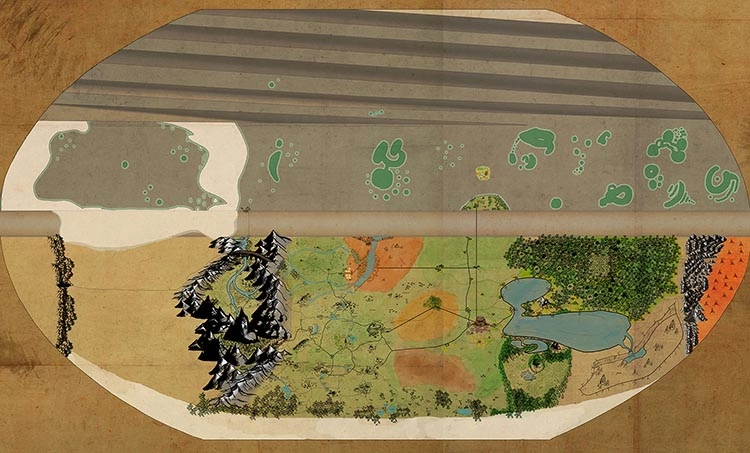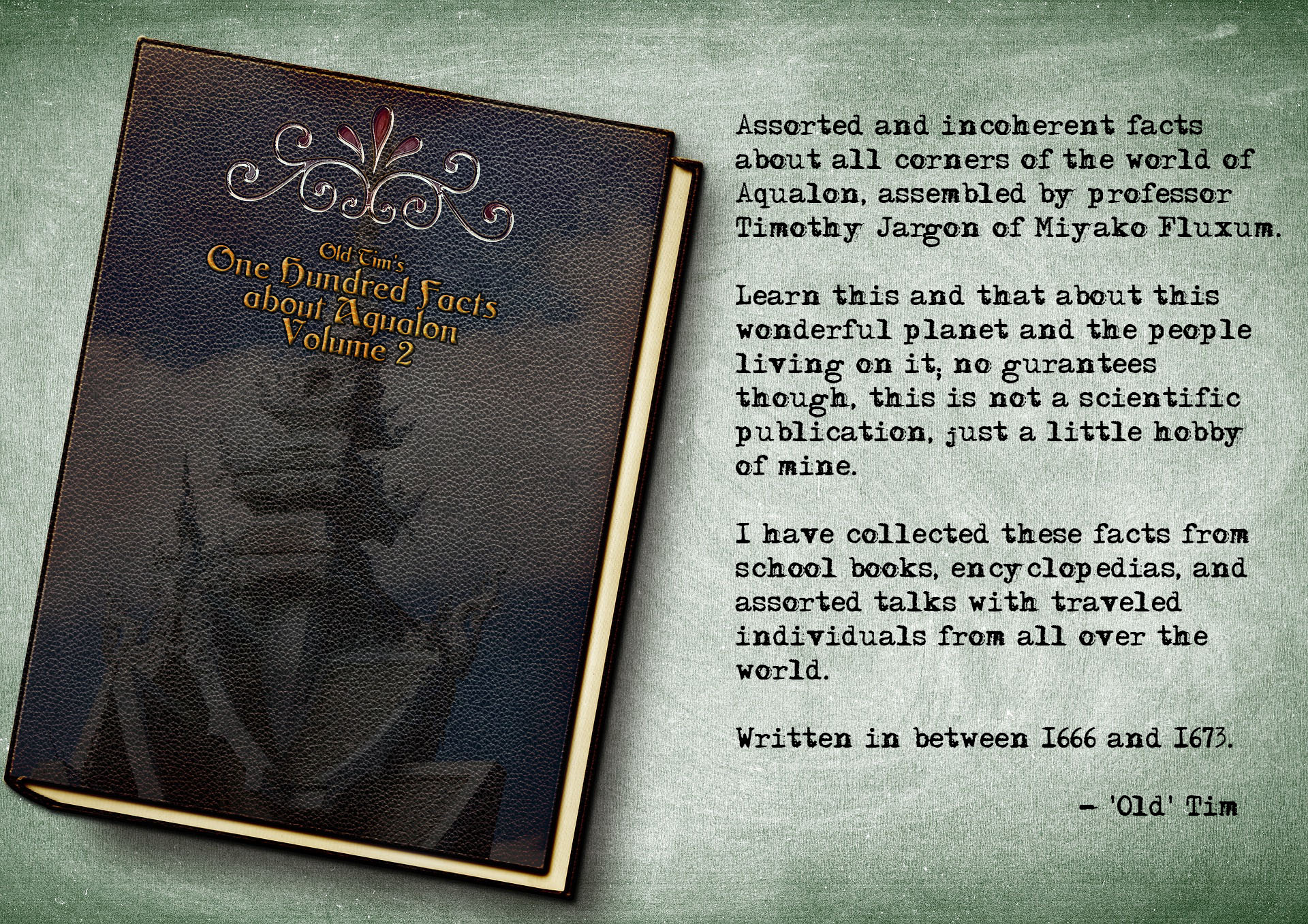Fact Number 101
Unbeknownst to the Brotherhood of the Null, the brokering of the Null Concord almost fell flat due to the Yamato Kingdom and city of Fulgrath being reluctant to commit to a long-term non-proliferation treaty against high-tier magic research and the development of WMDs and was only saved by the secret intervention of the Shadow Society, which leveraged extensive political and financial clouts behind the scenes to make the treaty happen in 156 AA (the Age of Awakening). While the Senate of Fulgrath in its current form was instated with the signing of the Great Charter of Fulgrath in 292 GE (the Age of Gears and Elements) during the Founding of the Five Cities, a much smaller proto version of that senate existed to advise the Asterock family on matters of state. The Asterocks were the house of the Margrave of the Northwest, who ruled the northwestern Middle Lands back then, and several senators who were on the fence or flat-out opposed to the signing of the Null Concord inexplicably changed their positions over night during the negotiations.Fact Number 102
The Brammenwoods are located between Altonar and the Western Walls of Weltenend. They are the largest forest on Aqualon, larger even than the great Odenwald Forest. There are long vines that wind across the forest floor all the way from the Iron Belt; they are called dragontails and have tough iron scales with material sequestered from the Rusty Shore with powerful acidic roots. Strange, iron-based crystals 'ripen' underneath these scales and are collected by male gem-tailed squirrels, which store them in tree holes and adorn their tails with to attract the female's attention. Once in the tree holes, they amplify the soul power of the tree in a to date unexplored manner, making the trees grow faster and stronger, leading to the largest trees on Aqualon being located in the Brammenwoods. Sometimes they will grow their tree holes shut in sudden growth spurts and many trees there have shiny gemstones encrusted in their bark. A "Bramma" is a semi-finished slab of steel, and the Brammenwoods get their name from the scales of the dragontails. The Brammir, keepers of the Brammenforts and rulers of Vechnaya Bramma, harvested the Bramma of the dragontails with great effort and secret magics during the First Age and the Age of the Iron Divide, covering the walls of their forts in them and smithing them into weapons. But their secrets of Bramma harvesting were lost with the waning of the Age of the Iron Divide, and to none is the name “Age of Awakening” more bitterly ironic than to the Brammir.Fact Number 103
North of the Brammenwoods lies the Glade of Druith, just past the great Lake of Glazglubin that is squeezed between the two forests. Druith is home to the Schamani of Druith, who stayed neutral during the Great War, much to the dismay of the other Nordmen and Old Gods. However, the whole Glade of Druith was declared a nature and culture preserve when the Null Concord was signed during the Age of Awakening, a point brought forth by the technocrats of the UOBT during the negotiations, and during the war efforts, the Nordmen were prevented from invading Druith by the Allied Forces. This happened in 28 AH (the Age of Heroes when a massive host led by Jörg the Giant and Grand Druid Brynwain gathered by Ravensburg to storm Druith, the Keepers and technocrats of Altonar rallied for a mighty sideswipe against their forces and thwarted them from penetrating the Wall of Druith, a great row of winter willows, which encircles the glade. Jörg aimed to secure the magically fertile lands of Druith to supply the North and unite all Kaltani tribes under his crown, while Brynwain had struck an alliance with him to gain access to Vaenndrasil and the well of power contained within the wood of the great tree.Fact Number 104
"Taishôgeki 大衝撃" is the name of a philosophy and corresponding book, written by a powerful historical figure of Aqualon. He had spent time in the realm of the Aesir and bested them in combat, traveling through the Great Land afterwards to seek wisdom in many places, speaking to many philosophers and mages of his time. Before writing the book, he fought one of the Valkyries on top of the tallest peak of the Yamato Mountain Range and defeated her. As the legend goes, he ripped her soul out of her shattered body and forged it into a great metal gate that connected the physical world to the Great Clockwork on top of that mountain, where he had a monastery built to pass on his teachings. This new intersecting point between the real world and the Great Clockwork gained some renown in certain circles, and in fact there is a certain tradition in the far-away technocrat megacity of Borealis called “the Walk of Skeptics”, where those who doubt the existence of the Great Clockwork will journey to the monastery to step through the gate and experience it for themselves. So far, most who have taken the Walk of Skeptics have returned alive from the other side.Fact Number 105
There are 15 ur-souls of tremendous power that are continuously reborn on all incarnations of Aqualon. All 15 are tied into the five elements, 3 too each one. Per element, one is born into a person, one is tied into a powerful weapon, and one is the ur-soul of that element itself. The person is called a Keeper, and the Keeper's weapon is his or her resonator that allows their soul to connect to the ur-soul of their element, controlling it freely and without the use of their own soul power as mages would. In the Old World during the early ages of the Nine Realms, the weapons lay buried in the ground, and one day when the Great Tale was told, the collective unconscious roused the Soul Forge, today known as the Great Clockwork, and it, in turn, roused the Keeper weapons, which sheathed themselves into coats of their own elements and emerged from the bowels of the asteroid worlds as Elemental Titans, seeking out their Keepers.Fact Number 106
In 24GE during the implementation of the Declaration of Existential Independence, secret negotiations with the Clockwork Avatar Sanatana were executed by the Faculty of Clockwork Theology of Borealis with the support of the Council of Faculties. Special exceptions were introduced into the suppression field of the DVF Suppressors to allow for a narrow vector of connection for the souls of Borealis inhabitants codenamed "Lifeline". This allowed the willful pursuit of clockwork spirituality and the connection to the cycle of rebirth by citizens while still making magic within the limits of the city virtually impossible as DVF suppression prevents the circumvention of the inverse square law for DVF-based effects. Breaking the inverse square law, of course, is one of the ways magic can significantly impact reality where fields of various kinds weaken exponentially with distance. One of the most prominent examples of this application of magic are the technamagic hats of the Greenhorn family, which double as summoning horns for war moths. When sounded, the horn blast can be heard equally well all over the world, no matter where the horn blower is located. Blowing a Greenhorn’s horn (the magical variety) is very illegal everywhere Greenhorns live (Id est Borealis and Miyako Fluxum).Fact Number 107
When the very first sentient program of the previous world of Aqualon was switched on, its birth rippled through the Great Clockwork like a devastating tsunami. The existential machinery cracked and split as parts of it wanted to bestow a soul of it, while parts were opposed. In the end, with only one unit of Planck Time to work with, the compromise was reached to fit the new lifeform with a type 2 soul (animal-like) amalgamated from unbound soul power. While the Clockwork fell into chaos thereafter and eventually the sun went out due to the Clockwork Wars that ensued behind the veil of reality, the machine intelligence thrived and eventually migrated to a physical body heralding the rise of a new android race that coexisted with the humans until the death of the sun caused a mass extinction of mankind. The remaining android race took over the shells of human society, discovering fusion energy, eventually building a satellite grid of artificial suns to re-illuminate the planet and allow for the awakening of Aqualon's plant life out of the harsh mega-winter of no-sun. The android race persisted for millennia before the last unit shut down and the planet was scrapped and remade by the Great Clockwork. The Clockwork had suffered such damage that the regular reincarnation system (R²S) did not have enough soul energy to work at full capacity so 9 smaller shard worlds were created, joined by a river of soul energy dubbed Yggdrasil to lubricate soul energy exchange between the Great Clockwork and the new human race. This was the birth of the Nine Realms, the precursor to the current world of Aqualon.Fact Number 108
The Grand Academy of Fulgrath brought forth some of the most brilliant minds of the first century GE. Among them was Rudolph Molotov, who performed extensive conversion and measurement experiments of soul power and lightning magic, creating the existential conversion coefficient the "Molotov" [M], based on the Kunibert unit [K] for measuring soul power. Before the Declaration of Existential Independence and the jumping to the South Pole of Borealis in 25 GE, Rudolph Molotov and Vincent Kunibert Greenhorn were close colleagues that inspired much of each other's work. Molotov's extensive research and experimentation with soul power to energy conversion, electromagnetism, and electric field theory led to the invention of the Molotov Tower, a tall capacitor tower built to harness the energy of lightning strikes to store as electrical power in large fuel cells. The first large-scale Molotov Tower was built as a proof-of-concept next to the then just Grand Academy in 175 GE. This tower, affectionately called “the Burning Tree” by the students of the Grand Academy of Fulgrath is still used to this day, not to harness electricity from lightning strikes - at least not as a means of power generation - but for the students to practice their lightning magic on it.Fact Number 109
When the city of Fulgrath was planned and constructed around the academy between 251 GE and 312 GE, more Molotov Towers and so called Cloud Stacks were constructed, which were meant to vaporize large quantities of water harvested from the Eel Holes, small but incredibly deep bodies of water nearby which connect to a vast underground supply. Generated clouds were agitated with lightning magic to create targeted lightning strikes into the Molotov Towers. The magical industrial revolution started two to three centuries earlier in Fulgrath compared to the other four cities of the Middle Lands, who started out with the invention of Spell Ink in the 9th century GE. In 350 GE already, the streets and houses of Fulgrath were powered by electric light, long before the invention of magus lamps that use fire magic spell ink mandalas. This proclivity for raw, only semi-magical invention made the culture and science of Fulgrath very appealing to Miyako Fluxum, which was founded in 125 GE after separating from Borealis. After retaining good relations with Fulgrath for two centuries, around the 4th century GE, Miyako Fluxum declared Fulgrath an official partner city, and more extensive cultural and scientific exchanges were facilitated after that, including bigger trade agreements, making Fulgrath one of the main suppliers of food stuffs and manufacturing for Miyako Fluxum.Fact Number 110
The Hank & Jordan & Tenzer Corporation have diversified their portfolio quite a bit since its founding in 390 GE. Turning into a lucrative business, they have reclaimed some of the old Hank & Jordan's cooper works and shipyards, opened profitable trading routes across the Corsic Ocean, and even published a series of story books called "Ferry Tales of the Ocean Belt", which boasts twenty-four large volumes by now and a roughly five-thousand issue story magazine called "SILFs of the Sea" has been in circulation around the Corsic Ocean and even the Great Land since 1304 GE, coming out monthly pretty much ever since. SILFs, Stand-in Loan Ferries, of course, are subcontracting mages that have qualified for a freelance HJT Ferry license, in exchange for a percentage of their fee. Their disadvantage, compared to Ferries, is that they have no steady employment and salary with HJT.Fact Number 111
Most of the larger streets of the Severlin Special Ward of Aerialis have been framed by wisteria that bloom beautifully in spring and sometimes summer, creating light canopies of purple hue and delightful smell. There are spring festivals hosted by the Severlin family to promote themselves and garner favor with the citizens and other noble houses, and the wind shrines of the Severlin Special Ward are most visited during that time of the year. Of course, the mansions of the Severlins and their branch families sport quite lavish gardens as well, some of which are open to the public during certain times of the year in order to display the wealth and prestige of the family. While not one of the direct ruling families of the city of Aerialis, like the Van Haag-Taira family, the Severlins are still in charge of a large city ward and well-liked in the general public, giving them significant political power.Fact Number 112
There are three major ports on the southern Rusty Shore: Nankô (南鋼) above the Yamato Kingdom, Blacksteel above Arkatrash, and Ísenwyll along the Axis of Steel. These are the first targets for most who cross the Iron Belt towards the Ocean Belt, as a clear-cut Rusty Shore meets relentless waves on the other side, save for Ísenwyll, which lies on the island of Svalbrynd that hugs the Rusty Shore. Nankô is connected with the oldest capital of Yamato, the southernmost city Nanjing or Nankin (南京), by way of the Hagane no Michi (鋼の道), the “Road of Steel”, an artificial stream that crosses the Iron Belt and is used for transportation.Fact Number 113
The Rusty Shore port of Nankô (南鋼) has been owned by the West Yamato Trading Company (WYTC) since 1320 GE, one hundred years after the company was founded. Today it is one of the main players in the naval trade business, competing mainly with the Hank & Jordan & Tenzer Corporation as well as various big time smugglers, most of which tie back into the Jamphel Yeshe drug cartel. Of course, some of them are also connected to the notorious Yamato Black Market, which has, at times, led to unlikely alliances between scoundrels and the WYTC in a bout to take out or at least harm the competition. The Commonwealth of Corsia could be a major player in trade as well, but they outsource much of their capacity to HJT while specializing in a military navy themselves.Fact Number 114
The Axis of Steel is a coalition comprised of the technocrat city of Altonar in the middle, the Kaltani fiefdoms of Ravensburg to the north, and the Angel Saxon and Skôt colony of Svalbrynd to the south. The alliance was founded in 598 GE when Altonar was looking to severely enhance its iron supply lines, looking both to the Iron Belt, certainly a large deposit, though one with magical resistance to strip mining, and to the Nordmen, who had an unusual access to the coveted metal through the Old Gods. Though many voices in the Middle Lands and Yamato Kingdom clamored against the last truly non-isolationist bastion of technocracy allying themselves with the war-mongering Nordmen, ultimately a lot of stability came to the Great Land and the Corsic Ocean thanks to this unlikely alliance.Fact Number 115
Since the 1698 HJT Files - Guantil-ya Survey Corps: Incident Reports, people of the Ocean Belt and beyond have taken to calling Rim City, the last Borealian outpost beyond the Spiral Sea, Chaos City. At first, people stopped going there because of the Guantil-ya Quarantine instated by Rim City in the 1650s GE, but after information from the classified HJT incident reports leaked and spread, people stayed away on their own volition, and nowadays, people who get shipping duty to Guantil-ya Harbor consider themselves the unlucky ones that drew the ill will of their superiors.Fact Number 116
During the top-secret surveying of Guantil-ya in recent decades, those trained in the use of Altonar multimeters and in possession of one of these marvelous contraptions quickly fled the island when coming along on one of the HJT survey corps excursions. There is fire in the air in Guantil-ya, and it can chase you down across the globe once it has marked you. Since the 1700s GE, the people of the Corsic Ocean will tell anyone who will hear it: "Don't go to Chaos City. There is ghostly fire in the air and dark things on the ground."Fact Number 117
In the wake of the Birth of Balsibart, a new wave of dark animancy followed. As his strange vanishing of entire communities across the Ocean Belt and ultimately, the Great Land, caused fear and upheaval, animancers came out of their hiding to sneak in from behind and sequester their fill of souls. Many dark deeds were done during the 17th century GE until, in 1682 GE, Atlas Muundir, Lord of Water, defeated Balsibart the Bard at the Battle of the Saltplains and the upheaval on the Ocean Belt settled enough for HJT and the West Yamato Trading Company to mount animancer hunts, supported by the Church of Pure Souls.Fact Number 118
The Middle Lands Magic Research Consortium (MLMRC) is an organization of scholars from all five Magus Academies of the Middle Lands: The Spire of Rahn, the Bonfire Shrine, the Grand Academy of Fulgrath, the Gladering University of the Arcane, and the Rickard Leeuw Magistorium, which spend one month each year together at the Tower of Five to convene a research think tank and meet up on four other annual occasions to hold research symposiums. The MLMRC traces its origin back to the Rahn Hall Symposium of Middlish Scholars in 79 GE, where inter-academic ties were forged within the scholarly community of the Middle Lands. After fifteen annual symposiums, the Middlish Consortium for the Arcane (MCA) was formed from the core members. It experienced a number of different waves and revamped itself as the Middlish Consortium of Joint Research (MCJR) in 193 GE and the Progressive Circle of Magic and Science (PCMS) during the Founding of the Five Cities in 285 GE. It fell apart during the Twin Centuries of Arcanism, from 600 GE to 805 GE when the Magus Academies became withdrawn and isolated in their research, hording knowledge in protected libraries. In 810 GE, voices arose that demanded the revival of the PCMS, which reconvened for the first time in centuries in 811 GE, spearheaded by Augustus Leeuw, under the new title of the Middle Lands Magic Research Consortium (MLMRC). They proceeded to pioneer a number of magical discoveries after that, the most prominent one being the invention of spell ink in 820 GE. Since then, the research of the MLMRC has shifted predominantly to the development of new magic engines.Fact Number 119
The largest tree on Aqualon is the Vaenndrasil of Druith, located in the Glade of Druith. Ever since the creation of the grand glade by the first schamani Erknaz Jôtison, the sapling of Vaenndrasil has been carefully tended and infused with schamani magic, making it grow larger and larger each year until it eventually outgrew even the gemed trees of the Brammenwoods. Today, it is home to the largest settlement of Druith, and regular rites and festivals are held in its honor and in honor of Erknaz. It is also here that the wandering tribes of Druith gather at the turn of the centuries so a new Great Schamani may step forth. Their purpose is to fuel the life force of Druith, and when they are spent, a new one takes their place.Fact Number 120
The Kaltani Fiefdoms of Ravensburg are located largely around Loch Môrdryn, which is frozen over for more than 200 days of the year. During this time, the residents still practice ice fishing, but there are enforced fishing limits on silverback trout throughout this time as the fish only replenish after their breeding season when the lake has thawed completely in high summer. The Ravensburg Kaltani actually trade large quantities of silverback trout to the Glade of Druith each year in exchange for the magically enhanced fruit picked in the Druith orchards all over the year. Silverback trout is also shipped to Altonar using their patented refrigeration technology, and fish from Ravensburg is enjoyed there as a delicacy, while the Ravensburg Kaltani have grown quite fond of Altonar spice, a zesty spice mix.Fact Number 121
The Great Lake of Glazglubin is located between the Brammenwoods and the Glade of Druith and is so staggering in size that it is just called the Sea of Glazglubin in many tongues - especially local ones. It was here that the Skôts and Angel Saxons built their first long-ships, trying to get to the other sides (the Brammenwoods and the lands before the Western Walls of Weltenend), hoping to find new tribes to plunder there (which they did). In time, they used their "sea"-faring technology to sail the Ocean Belt, after actually carrying several long ships across the 150 kilometer broad Iron Belt. Had they arrived directly at Svalbrynd, which is the only island connected to the Rusty Shore, they would have never needed put their ships into the waters of the Corsic Ocean before creating their settlement, but alas, they missed the island by quite a bit and went on a great pillaging tour, becoming some of the first great pirates of the Corsic Ocean.Fact Number 122
Lumina Aka is one of the five capitals of the Middle Lands and has a sort of old-established sense of wealth to it, owing to the old manors and forts of Lord Byren and the barons of his fiefs from before the Founding of the Five Cities. Quite a bit of architectural zeal and vision went into the planned construction of the city, which was erected close but not too close to the Bonfire Shrine, by the genius architect Sven Fanfahria, who envisioned a white city of stoae and forums, using clever aqueducts to transport sufficient quantities of fresh water from the upper reaches of Mt. Tarkaal down into Lumina Aka, the city of fire. (Because fire is great for making soup, but just fire is not going to get you far). Extensive quarries were first built and connected to sufficient infrastructure between the northern side of Mt. Tarkaal and the site of Lumina Aka during the Founding of the Five Cities. There, the white stone was quarried and prepared for the construction project.Fact Number 123
The Green Baronies, three domains that each contain one ruling city, rule the fertile and wealthy Saltplains. They owe fealty to the Tower of Five and pay Middlish taxes, but are also granted broad trade and customs subsidies when trading with the five capitals of the Middle Lands. The domains barely have a military between them, just enough to police their own holdings to a degree, but are reliant on Middlish might to make sure their neighbors don’t act on their envy for the fertile region and its treasures.Fact Number 124
Where the Red Sands meet the Salt Plains, saltwater that weeps up from the ground has created large, high quality deposits of salt atop the sands. After many bloody disputes and wars over ownership and national borders, the salt harvesting operations are currently being undertaken by the Green Baronies, the ruling power of the Salt Plains. Arkatrash, the Salt Plains, the Middle Lands, and even parts of the Yamato Kingdom import large quantities of Friedbert salt regularly, making the salt fields one of the two greatest sources of income for the Salt Plains, the other being their prized livestock and the products made from it.Fact Number 125
Arkamanthali was the great line of paros that ruled during the time of the great Arkatrashian Empire. They built the greatest pyramids of the Red Sands as their palaces and later tombs, which still rank among the tallest buildings of the world today. During the Age of Heroes, the empire almost fell into ruin and only the great city of Arkatrash remained from the days of the great empire. The pyramids were the only structures to resist the sands over the past seventeen centuries, all other traces of the great empire beyond Arkatrash were swallowed by the desert. Still, wanderers in the desert will sometimes be swallowed by quicksand and spat into dark corridors that lie buried beneath the Red Sands, telling tales of the once great empire of Arkamanthali before becoming their final resting place. Those who go done, never come back up…Fact Number 126
The Golden Sands lie directly between Lumina Aka of the Middle Lands and Altonar, the City at the Water Vent. They are one of the two great deserts of Aqualon and home to the scattered houses of the large town of Midas Creek, which was built around the oasis created by the midas trees, strange plants that pump water out of the deep ground like a noria. One road leads from Lumina Aka to Altonar through the Golden Sands and Midas Creek called the "Trail of Midas", but it is far less traveled than the Road to Altonar, which goes around the Golden Sands to the North.Fact Number 127
Brynwain Fever, the magical sickness brought forth by a druidic ritual only the Grand Druid of the Kaltani Brynwain knew when she still lived, was one of the main reasons the Great War lasted for over 300 years. While the Nordmen were outnumbered and outmatched on many occasions, Brynwain's vicious attacks on the enemy food supplies, turning entire fields and forests into blighted heaps of ash, lead to critical food shortages that kept the Allied Forces off balance long enough for devastating guerilla attacks by Angel Saxon strike forces and the Old Gods themselves, leaving the Kaltani, Skôts, and Gallians to hold newly acquired forts and reclaim the land using the powers of Kaltani druids. A failed Brynwain Fever ritual led to the creation of the extensive Brynwain wastes where nothing grows to this day.Fact Number 128
The tribes of Druith are relatively nomadic, traveling around with the seasons and herds of stórelg (giant elks) that travel across the Glade of Druith. The Druithen hunt the stórelg in moderation and take good care of their population and the vegetation that gets damaged by the great creatures. Though they could reinforce the stórelg trails and create proper road networks, they refuse to harm the lands of Druith in any way, for they are sacred to them. During the Great War, Kaltani war leaders saw the stórelg as the ideal mount, and they became one of the reasons they wanted to invade Druith so badly, seeing how the Druithen would not share their game willingly, but in the end, the Allied Forces kept the Kaltani at bay and the stórelg have never been kept as livestock or mounts to this day save for one or two very special exceptions.Fact Number 129
Where Angels LiveBlack as loch in Saxon land
The mist will gather glen to glen,
And shine like rainbow luster where
The Angles live in stony halls.
Fact Number 130
The Gunger Valley holds the deep Loch Gunger, around which the Skôtish villages of Gungerstein and Agley are situated. Fed by the Ravensbach River, which flows out of the Yamato Mountain Range, the lake swells during the melting season, and it will regularly flood the entire valley, sometimes leveling the villages in the process. During these times the people seek shelter in Albeney and return after the flood season to rebuild.Fact Number 131
The Shadow Society is one of the most powerful organizations on Aqualon. Though most people know of them, the information is very distorted by the myth that precedes them. They perform clockwork magic using stolen Angel Saxon knowledge, which they use to forge powerful Onyx Lanterns. They have a number of Halls of Light scattered throughout the Great Land, that shine bright beacons into the night sky, produced by the many lamps that are stashed inside and that light up when Shadow Society magic is used. They can hide perfectly in the shadows and even travel through them to distant places, at least so the rumors go, and they have used their powers for assassination, thievery, and reconnaissance, all of which has put them in a poor light, broadly speaking, though some scholars and powerful individuals have postulated that their agenda is much more political and might even be of a positive nature. This viewpoint is owed to a recovered and decrypted "Shadow Codex", the guide texts of the Shadow Society's core tenants and beliefs, which were considered to be quite ethical and meticulous, though somewhat morally questionable in their execution, by the Middlish scholar Hendrick Renswies in 928 GE. While his partial decryptions and papers still remain in the archives of the Rickard Leeuw Magistorium, the recovered Shadow Codex was stolen in 953 GE.Fact Number 132
Matter-energy transmutation is magically possible but requires a preposterous amount of soul flops. Together with soul power, soul flops are one of the two quantifiable properties of the soul. They define the amount of quantum computations a soul can perform per Nikter time (the shortest measurable amount of time, which was defined by Karl Nikter in 164 GE). The base requirements to perform matter-energy transmutation are in excess of eight hundred times the average soul flops of one human soul and only very tiny amounts of matter can be converted into energy and back. The first soul computer capable of performing the procedure on a small scale was constructed in Miyako Fluxum in 1610 GE using ASAs (Artificial Soul-like Amalgamations).Fact Number 133
Pattern-based matter transmutation is something that has been made possible by a magic engine called a "transmutation furnace". It was invented in a cooperative effort of Arda and Fulgrath in the late 1610s GE and incorporates hundreds of spell ink mandalas that utilize earth, lightning, and fire magic to change the atomic and molecular matrix of appropriate raw materials into the shape and composition of a prototype material placed in a special compartment of the furnace. Placing a cut diamond into this compartment and an appropriate amount of coal into the furnace will, with considerable time and soul power investment, turn the necessary amount of coal into an identical replica of that diamond. Furnaces were used to produce materials and products that were extremely difficult to manufacture in the beginning, but with their proliferation throughout the Middle Lands between the 1640s and 1690s, their use and application became more widespread. However, they have been barely streamlined in that time, and replicating even small objects requires several people to power the magic engine for hours at a time. Actual matter transmutation, for example the elusive lead to gold transmutation ever sought by alchemists and magic engineers, is still impossible with the furnace, which is ultimately a misnomer and should be called "transfiguration furnace", a title their inventors thought to be less appealing.Fact Number 134
Vinclav was a powerful animancer who lived in the 4th century of the Age of the Iron Divide. He traveled across the Ocean Belt tricking people out of their souls using a powerful key-shaped artifact he had created. After 200 years of terror following in his wake, he finally perished at sea, but his legend had become immortal by then. Pirates cursed his name and warded themselves against the evil they thought he imposed on them, and in the year 132 of the Age of Awakening, the famous poet and author Heinrich Thadeus Borgerat wrote an influential work called “Glint” that portrays Vinclav in a new but still quite sinister light. This work lead to the new religious waves in that era, causing the emergence of the Church of Pure Souls.Fact Number 135
"On this side of the Giranja lies the great city of Arkatrash, on the other side lie fields and plantations, the food basket of the city so to speak, though the sullied ones live someplace over there as well; blighters and such. Daily, many ships transport food, people, livestock, and tools from one shore to the other. Of course there are also many fishing boats that tether themselves to those arches around the center, or close to it, to fish the river. You can get exquisite fresh fish here in Arkatrash." - Plâton Rai'enjoh, 1703 GEFact Number 136
The Giranja is the largest river on the world of Aqualon. The most populous and developed parts of the city are on the east side of the river, while many farms and occupations believed to be "unclean" are predominant on the west side. On several points along the river, lines of wooden arches are anchored into the ground between both shores, holding up ropes that are turned endlessly by great waterwheels. Little ferries latch onto the rope to transport wares and ferry people across. Those believed to be "unclean" are called "Sullied Ones", and they come from a variety of occupations, mostly those dealing with blood and the deceased, but also include spellblight victims.Fact Number 137
In 270 AH, still decades before the end of the Great War and after two centuries of technamagic R&D, the high technocrats of Borealis, the northernmost city of their faction, completed their research into large-scale clockwork travel. A jump drive was installed in the city's heart, and Borealis moved to the South Pole, where it absorbs the small outpost Australis, becoming an isolated fortress city nation at the end of the world. This removed the strongest member of the Unified Ocean Belt Technocracy but did not happen from one day to the other. Executive and legislative power was slowly shifted away from the Council of Faculties to the remaining members of the UOBT: The Hooper Chain, the Four Pillars of Sternsmooth, and Treaeyne. The Guantil-ya navy, the most powerful in the world at the time, was disbanded with almost half their vessels being laid in ordinary and the other half being sold to the remaining UOBT to finance the necessary infrastructure projects ahead of Borealis at the time. Once the jump had been performed and Guantil-ya fell out of the UOBT, it rebranded itself as the Commonwealth of Corsia, slowly absorbing other island nations such as Rastrowel and Nyingma as members or affiliates.Fact Number 138
Since the invention of firesticks and cannons in the Yamato Kingdom during the Age of Heroes, firearms have come a long way. During that Great War, the design was taken up by the Maritime Technocracy of Quantil-ya and refined into the double-sectioned firestick, which was used by Yamato troops during the war. The matchlock and later flintlock were invented during the early centuries of the Age of Gears and Elements, but the development of firearms stalled after that due to a lack of large-scale wars. Instead smithing and production methods were refined, proliferating the flintlock gun and rifle throughout the Ocean Belt, eventually spreading to parts of the Yamato Kingdom, throughout the Axis of Steel, and Arkatrash, which implemented imported Corsic Ocean firearms in select small units of their military. This spread of flintlocks to the Great Land was, however, more deliberate than the recipients may have believed it to be: the remainder of the Maritime Technocracy of Guantil-ya, now called the Commonwealth of Corsia had invented percussion cap firearms in the late 300s GE, and the phased out, unreliable flintlocks of the CC joint naval and domestic forces were sold on the cheap over to the Great Land during lucrative upgrading campaigns.Fact Number 139
The primer systems of percussion cap firearms were refined and updated over the centuries since their invention in the 300s GE, giving rise to technologies such as auto-primers, which prevailed for a long time. The occasional maritime wars of the Ocean Belt were nowhere near enough to spark the level of innovation to make the next leap in firearms technology, until a fateful day in 1582 GE, when the young technocrat Marcus Fortknocker, who had attained an Inventor title at the University of Altonar ten years quicker than any of his colleagues had an idea. He invented the first self-contained cartridge, which contained the projectile, gunpowder, and percussion cap all in a single shell that could be easily loaded and would be fired upon being struck by a hammer. His invention sparked a revolution of firearms, which quickly spread up the Axis of Steel and across the Corsic Ocean. The first revolver was invented in 1643 GE, but has proliferated slowly, as most people on the Corsic Ocean today still use guns and rifles with a shell chamber, and people of the Great Land often still rely on outdated percussion cap models as the supremacy of magic is frequently overestimated in the Middle Lands, a stance they project fiercely onto the surrounding nations.Fact Number 140
The bitania is a typical clothing that has been worn in Arkatrash for thousands of years. Though there have been irregular waves of Middlish and Yamato fashion in the great desert city, the white wool cloth is still prevalent throughout its populous. It is a relatively simple piece of white or sometimes colored cloth of up to 3 meters of length, which is wrapped around the body in a specific fashion, learned at an early age in Arkatrash. It can be tied to expose more or less skin, depending on the weather and time of day, providing variable protection from heat, cold, and harsh sunlight.Fact Number 141
Before the fall of Jamphel Yeshe came the rise of Jamphel Yeshe. The five Grand Sages walked across the Ocean Belt with their acolytes and build a grand monastery on this Promised Land. Only when they strayed from the path of the Great Clockwork and tore the island out of its tapestry, did Jamphel Yeshe fall into depravity. These days, the monastery is the mansion of the current top man of the Jamphel Yeshe drug cartel.Fact Number 142
The Pool of Masika is a great lake inside the Canyon of Khepri in the Red Sands. It is fed continuously by the mighty Giranja but is also drained at the same time, as a great hole in its bed near the Rusty Shore sucks the water in through a great whirlpool, presumably to feed it into the Ocean Belt somehow.Fact Number 143
The Middle Lands Magocracy is the most powerful nation of the Great Land and is comprised of five principalities ruled by the Council of Five, a true magocracy headed by the Keepers of the Elements, which are reborn over and over, assuming power over their principality once of age. Here lie the five great cities of the Middle Lands: Aquaris, Aerialis, Arda, Fulgrath, and Lumina Aka as well as the Tower of Five, where the Five Keepers reside.Fact Number 144
The Graan family was among the first settlers to arrive on Graanshoof, together with the Hoofer family. While the Hoofers did their best to proof the island against the regular floods using dyke lore they had brought with them from Guantil-ya, the Graan family dug the town well, erected the blacksmith's hut, and prepared timber from the Whistling Grove for the construction of a small village. They still enjoy considerable status on Graanshoof to this day.Fact Number 145
Within the Brotherhood, a number of titles express the status of a Null. The three standard ranks are 'Initiate', 'Acolyte', and 'Master'. The Three-Eyed Sentinels hold their own separate tier but are considered equals to the masters. Each rank has the sigil of their rank painted into the black moon of their frontal Sign of the Eclipse. The Three-Eyed Sentinels linger in dark halls where they stare into the Great Clockwork through their fifth gates, their minds eroding, but their eyes seeing true. Like the cawing of crows, their mad chatter greets those who dare venture into their midst, and the words they speak often sound like the ravings of madmen… until a phrase strikes true and shakes the listener to the core, for they know many things mortal men should not know.Fact Number 146
The Brotherhood of the Null owns large tracts of land at the foot of the Eastern Walls of Weltenend, which were given to them as part of the Null Concord. Because some of the mountains contain valuable ores, such as silver and scheelite, which is turned into tungsten, they lease these regions out to mining consortiums and farmers to supply them. These generally belong to the Yamato Kingdom, which boasts an ancient tradition of mining and metal work, dating back to the Old World where their ancestors, the Swartalben procured the various ores and gems and forged the alloys used by the Albenmannen to create magical arms, armor, jewelry, and architecture.Fact Number 147
Animancy is an unusual variety of clockwork magic where souls are used as a raw material to create magic items, prolong lives, and unlock unusual powers. Technically, Angel Saxon smithing is also animancy, because they imbue their works with a fragment of their own soul, and there are Kaltani who practice animancy to make things grow or wither, prominent examples of this being the former Grand Druid Brynwain or any schamani of Druith. However, the kind of animancy more commonly found on the Ocean Belt is, well, focused on using the souls of other people, which is frowned upon, illegal in most societies, and also viciously persecuted by the Church of Pure Souls. Vinclav himself - the historic Vinclav - was such an animancer, and his dark deeds still resonate throughout the Corsic Ocean. But there are yet others that still roam free and perform dark deeds in secret. On rare occasions, animancers have been found and magus parties gathered to hunt them down, which sometimes included masters of the Monastery of Five Paths and 'Ikeikekai of Ka Hale Akamai, who were usually all too eager to go on the dangerous journey if the head of an animancer was the prize to be won. Animancers are universally despised.Fact Number 148
Aqualonian maps were relatively crude and not widely distributed until the advent of the Van Maxwell School of Logic and Sciences, founded in 432 AID. When the university began to expand its faculties into the fields of mathematics and geography, the first relatively accurate maps of the Seventeen Yonder Islands were drawn up. The only contender was the relatively young Yamato Kingdom, which had created extensive maps of the Yamato Mountain Range using archaic techniques of measured pacing, measuring rope (which was susceptible to length changes caused by humidity), and plane tables. The scholars of the Van Maxwell university, however, already had access to the sextant, which had been invented in 384 AID to aid sailors navigate the Corsic Ocean, and their own creation, the theodolite, which was invented by Jensen Buren in 456 AID.Fact Number 149
Ortraud is one of the three capitals of the Green Baronies, which rule the fertile and wealthy Saltplains. It used to be a magus tower called Ornburg, which was owned by the grand magus Volkner von Horvath. Ornburg had been erected in the decades that lead up to the First Invasion, which kicked off the Great War, though von Horvath had no idea that the Nordmen were planning an attack. He had been concerned with Yamato aggressions against the eastern Saltplains and decided to move his research base from the northern Saltplains up here to the East. After von Horvath perished during the Great War, his descendants took over his holdings and constructed a hamlet around Ornburg, turning it into the barony of Ortraud.Fact Number 150
The bayô is an equine animal, which shares characteristics with both horses and goats, that lives in the Yamato Kingdom and is able of bearing a rider, moderate speeds, and steep climbing. It has been domesticated by the Yamato people and used for safe, speedy travel through the mountain range and even as war mounts. Though less apt sprinters than well-bred horses, the bayô can deal with terrain that would bring most horses to their knees, and their endurance when climbing is second to none.Fact Number 151
"Yamato", literally meaning “The Great Harmony”, is the title for the land of Yamato and its kingdom, both of which extend throughout the Yamato Mountain Range, east of the Middle Lands and west of the Untamed Meadows. Parts of the Untamed Meadows are also part of the kingdom in the form of provinces, and there are even more provinces in the islands to the south of the mountain range, beyond the Iron Belt. The Yamato People were among the first to explore and survey the Ocean Belt.Fact Number 152
The Yamatoga Daijiten, "the Grand Yamato Moth Encyclopedia", is an old but nonetheless seminal work on the history, ecology, and biology of the three types of Yamato moths, which was written in 88 AA and reprinted in 143 GE as well as 273 GE after the publication of the Codex Riccardium: Magna Magia, the seminal work on magic history by Rickard Leeuw, founder of the Rickard Leeuw Magistorium. Because the codex contained two extensive chapters on the moths of Yamato, using the YGD as his core source, publishers believed this might make a reprint profitable.Fact Number 153
Hestia Bygate was a historically influential magus of fire, who was raised in the Bonfire Shrine of what would later become Lumina Aka, boasting an impressive career as a court magus of the Yamato court before falling out of favor for incinerating a large city called “Estverde”. After that incident, she became a dark chapter in the history books of Aqualon and is to this day better known as "the Mad Magus Hestia" or sometimes "the Witch of Mt. Tarkaal". Still, Yamato folk tend to view her in a more favorable light than most, since she brought much prosperity to the kingdom and many there saw the destruction of Estverde as a righteous act. Since it was an act of indiscriminate magical mass destruction, however, it shifted the public conscious about magic and led to the influential West demonizing Hestia and her act.Fact Number 154
The different varieties Yamato moths, Genus Insecta Lepidopter Yamatonis, share a so-called "floating belly". This organ accumulates methane gas, making the moths look bigger and increasing their surface area without adding weight to better utilize the winds of the Yamato Mountain Range for flight. They also have so-called "escape sphincters", which allow them to expel some of their gas for sudden bursts in maneuverability. This fact has been used by the Yamato people to domesticate murasaki moths and harvest gas from them. Gikitô, moth gas lamps, are powered with the methane gas extracted from the floating bellies of murasaki moths.Fact Number 155
The Twin Walls of the Abyss are two towered walls on either side of a mind-boggling ravine that cuts through the only level ground that could lead into the Yamato Valley. It is said that one of the earliest emperors was the Lord of Earth at the time and removed the only access to cut the kingdom off from the Middle Lands. They call that ravine Naraku no Soko, which simply means "Abyss", though the connotation is quite ominous.Fact Number 156
The great city of Fulgrath has a large district called "the Forge", which is where most of the magic engineers, smiths, and engineers are located. Amazing new machines are invented and realized here every day, though most of the truly monumental research is done in the Grand Academy of Fulgrath in the north of the city. While there are few local inhabitants of the district, it is filled with large buildings containing industrial smithies, furnaces, and other kinds of manufacturing plants, and here many of the artisans of the city work every day, coming from all over by way of the Travel Gates of Fulgrath.Fact Number 157
While electric carriages had their brief dawn in the city of Fulgrath, the need for a proper mass-transit system to connect the large areas of the city to each other was quickly realized, and scholars of the Grand Academy of Fulgrath and magic engineers from the Forge worked together for months until they received unexpected but welcomed help from Miyako Fluxum, the moving technocrat city, which had already become an important trading partner for Fulgrath. Together they created the transit towers, which harness soul energy and spatial distortion based on high-speed soul computation to warp so-called 'travel gates' together and allow people to move from tower to tower in seconds, regardless of distance. Before the travel gates, special proto-magic engines, called “Effigies”, from before the time of spell ink mandalas were manufactured by the Lockjaw Vehicles to fill a market that was dominated by bicycles at the time. And though the advent of the travel gates pushed effigies of the personal consumer market, larger versions are still in use in the industrial sectors while Lockjaw Vehicles, now called the Lockjaw Mandala Corporation, returned to developing and manufacturing bicycles, cycle-rickshaws, and electric bicycles.Fact Number 158
In the Forge district in Fulgrath, the central building is shaped like an old-fashioned kiln and generally referred to as just "the Furnace". Within its walls, the largest transmutation furnace of the world is located, and it churns out complex materials twenty-four hours a day, eight days a week, supplying the entire Forge district and the Grand Academy of Fulgrath.Fact Number 159
In the 1620s GE a monk called Constantine Rajavadi invented the Atlas Incantamentorum Atramenti, a spell ink atlas containing many pages of mandalas, which could be activated by simply leafing through the book and touching the mandala. This revolutionized magic engines and made magic commercially available to a broader part of the civilization. Spell ink mandalas run hot when touched, so even though things resembling spell scrolls with such mandalas on them were a thing long before the spell atlas was invented, they would burn up when touched, so only weak one-time applications in this form were possible. The atlas's pages were made from high-tech heat-resistant fibers and intended for continued use.Fact Number 160
The problem with spellblight is that it occurs due to more magic flooding through the inner gates into the soul than that soul can handle. The inner gates crack and magic-flow control goes out the window permanently. This has adverse effects on the human body and leads to a decrease in life expectancy and can even cause instant death if the sudden strain exceeds a certain threshold.Fact Number 161
There are extreme measures that can theoretically be taken to prolong ones life: On the magic side, there is the possibility of animancy, which is sometimes falsely called necromancy. Animancy bends and manipulates souls - usually those of others - to achieve certain things. One goal of animancers throughout history has usually been attaining immortality by stockpiling human souls within themselves or some other sort of vessel. On the technological side, there is the possibility of ribogenetic engineering, which is more or less the same as genetic engineering. The Greenhorn family of Borealis has invented and perfected this branch of science and has in secret, against the edicts of the ethics commission of the Council of Faculties, started and perfected a project to significantly augment the human body, and one of their founding fathers who currently lives in exile and is considered the original inventor of ribogenetics, Sagamund Greenhorn, is in fact one of the oldest people on Aqualon having lived through more than the entire current age (which has lasted 1703 years to date).Fact Number 162
Lost SpiritsShuffling through the fields of snow,
Two orbs of blue that gently glow,
Yet nothing else there to be seen,
Invisible, a taunting dream.
A chiming laugh, more like a snicker,
Atop the snow a hat of wicker,
Hides the streams of white.
But never closer will we step,
To us the snow, the white is death,
The purest, tainted blight.












